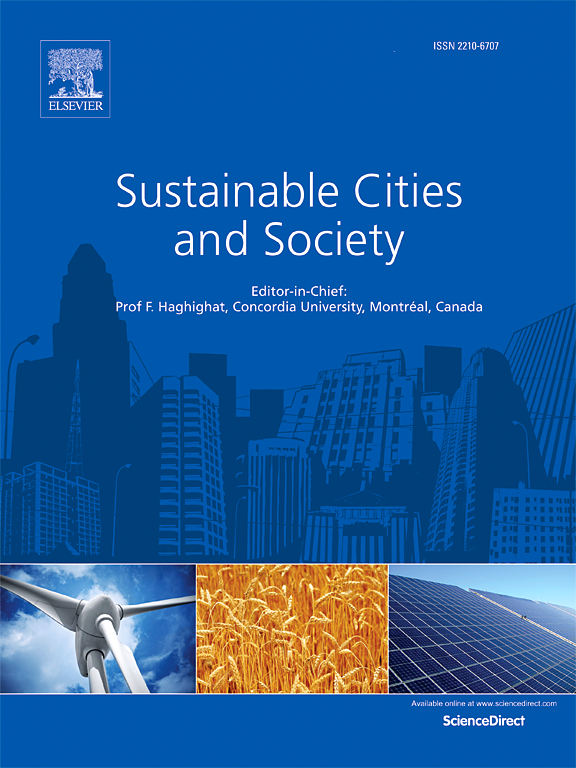Mitigating urban heat island through urban-rural transition zone landscape configuration: Evaluation based on an interpretable ensemble machine learning framework
IF 10.5
1区 工程技术
Q1 CONSTRUCTION & BUILDING TECHNOLOGY
引用次数: 0
Abstract
Research methods for mitigating urban heat islands (UHIs) have been widely documented. Nevertheless, the importance of mitigating UHIs through landscape allocation in urban-rural transition zones (URTZs) has rarely been emphasized in the context of intra-urban land scarcity and urban expansion in China. This study aimed to quantify the binary relationship between URTZ's landscape configuration and urban heat island intensity (UHII) by using an interpretable ensemble learning framework in Harbin, a megacity in China. After URTZ's identification, this study integrated Boruta algorithm, SHAP, ALE (interpretable machine learning techniques) and 7 tree-based machine learning models to assess the importance of URTZ's landscape configuration with both global and local angles. The results indicated that: construction land contributed most, with construction land ratio (23.20 %), separation degree (15.95 %), and maximum patch index (15.03 %) ranking highest. This was followed by agricultural land landscape shape index (10.31 %) and landscape diversity (9 %). Maintaining construction land ratio at 50–70 % can keep UHII unchanged; UHII at the grid landscape level can be alleviated when separation degree between construction land patches was above 0.7. The largest construction land patch within the grid was maintained at 20–40 or 50–70, which will not bring significant changes to UHII. The agricultural land landscape shape should be as simple as possible to reduce UHII; landscape diversity greater than 0.6 can reduce UHII, and <0.6 can increase UHII. These findings provide valuable insights into UHI mitigation and offer strategic guidance for ecological planning to promote sustainable development of large cities in rapidly changing URTZs.
通过城乡过渡区景观配置缓解城市热岛:基于可解释集成机器学习框架的评价
缓解城市热岛的研究方法已被广泛记载。然而,在中国城市内部土地稀缺和城市扩张的背景下,通过城乡过渡区(URTZs)的景观配置来缓解UHIs的重要性很少得到强调。本研究以中国特大城市哈尔滨为研究对象,采用可解释的集成学习框架,量化城市热岛强度与城市景观配置之间的二元关系。在确定URTZ后,本研究结合Boruta算法、SHAP、ALE(可解释机器学习技术)和7种基于树的机器学习模型,从全局和局部角度评估URTZ景观配置的重要性。结果表明:建设用地贡献最大,建设用地比例(23.20%)、分离度(15.95%)和最大斑块指数(15.03%)次之;其次是农用地景观形态指数(10.31%)和景观多样性(9%)。将建设用地比例维持在50 - 70%,可保持城市热岛指数不变;当建设用地斑块之间的分离度大于0.7时,栅格景观水平上的UHII可以得到缓解。电网内最大的建设用地维持在20-40或50-70,不会对UHII带来重大变化。农业用地景观形态应尽可能简单,以减少UHII;景观多样性大于0.6会降低UHII,大于0.6会增加UHII。这些发现为缓解城市热岛问题提供了有价值的见解,并为生态规划提供了战略指导,以促进快速变化的城市热区中大城市的可持续发展。
本文章由计算机程序翻译,如有差异,请以英文原文为准。
求助全文
约1分钟内获得全文
求助全文
来源期刊

Sustainable Cities and Society
Social Sciences-Geography, Planning and Development
CiteScore
22.00
自引率
13.70%
发文量
810
审稿时长
27 days
期刊介绍:
Sustainable Cities and Society (SCS) is an international journal that focuses on fundamental and applied research to promote environmentally sustainable and socially resilient cities. The journal welcomes cross-cutting, multi-disciplinary research in various areas, including:
1. Smart cities and resilient environments;
2. Alternative/clean energy sources, energy distribution, distributed energy generation, and energy demand reduction/management;
3. Monitoring and improving air quality in built environment and cities (e.g., healthy built environment and air quality management);
4. Energy efficient, low/zero carbon, and green buildings/communities;
5. Climate change mitigation and adaptation in urban environments;
6. Green infrastructure and BMPs;
7. Environmental Footprint accounting and management;
8. Urban agriculture and forestry;
9. ICT, smart grid and intelligent infrastructure;
10. Urban design/planning, regulations, legislation, certification, economics, and policy;
11. Social aspects, impacts and resiliency of cities;
12. Behavior monitoring, analysis and change within urban communities;
13. Health monitoring and improvement;
14. Nexus issues related to sustainable cities and societies;
15. Smart city governance;
16. Decision Support Systems for trade-off and uncertainty analysis for improved management of cities and society;
17. Big data, machine learning, and artificial intelligence applications and case studies;
18. Critical infrastructure protection, including security, privacy, forensics, and reliability issues of cyber-physical systems.
19. Water footprint reduction and urban water distribution, harvesting, treatment, reuse and management;
20. Waste reduction and recycling;
21. Wastewater collection, treatment and recycling;
22. Smart, clean and healthy transportation systems and infrastructure;
 求助内容:
求助内容: 应助结果提醒方式:
应助结果提醒方式:


